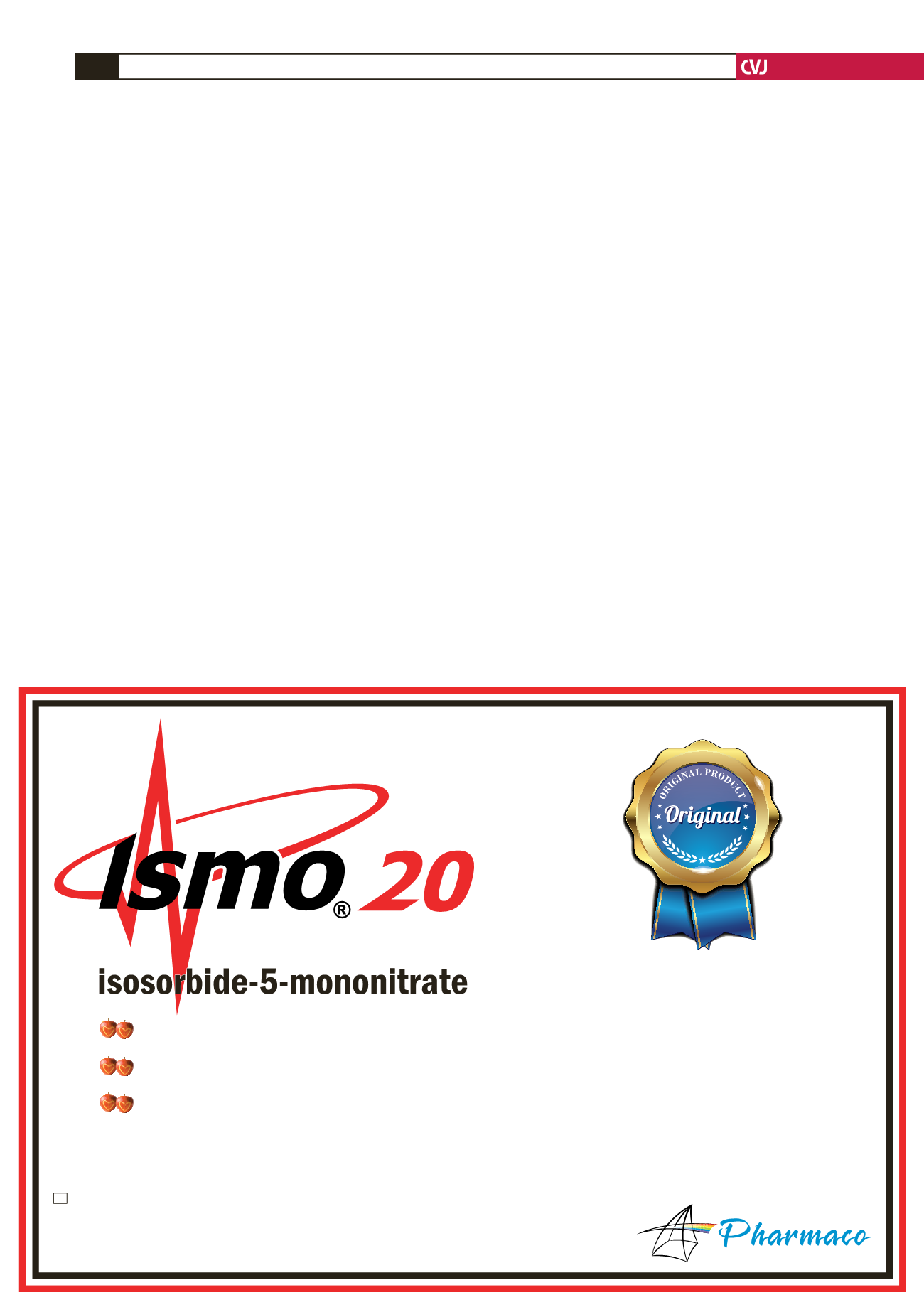

CARDIOVASCULAR JOURNAL OF AFRICA • Volume 32, No 3, May/June 2021
174
AFRICA
Trust the
!
Original
S3 ISMO-20 R/7.1.4/136. Isosorbide-5-mononitrate 20 mg/tablet.
For full prescribing information, please refer to package insert.
Pharmaco Distribution (Pty) Ltd. 3 Sandown Valley Crescent, South Tower, 1st Floor, Sandton, 2196; PO Box 786522, Sandton, 2146, South Africa. Tel: + 27 11 784 0077.
Website:
www.pharmaco.co.za1
Long-term prophylaxis and management of
Angina Pectoris
2,3
=
100%
bioavailability
No first-pass metabolism
4
Twice daily
dosage regimen shown
to avoid withdrawal and tolerance
References: 1.
South African approved ISMO package insert.
2.
Ismo 20 Product Monograph (2015).
3.
Abshagen, U., 1992. Pharmacokinetics of isosorbide mononitrate.
The American Journal of Cardiology,
[online] 70(17), pp.G61-G66.
4.
Thadani U, Maranda CR, Amsterdam E, et al. Lack of Pharmacological Tolerance and Rebound
Angina Pectoris during Twice-daily Therapy with Isosorbide-5-Mononitrate.
Annals of Internal Medicine.
1994; 120:353-359. IS_0120.
the world.
10
This case of pheochromocytoma rupture-induced
basal TTS is the first explicit report in the literature.
Conclusion
This case provides us with three insights: (1) young patients with
abdominal pain and clinical evidence of ACS should be checked
for pheochromocytoma; (2) the impaired LV systolic function
recovered in two to three weeks with timely mechanically assisted
therapy; (3) TTS did not re-occur even without taking any beta-
blockers or ACEIs after the tumour was removed.
References
1.
Ghadri JR, Wittstein IS, Prasad A, Sharkey S, Dote K, Akashi YJ
, et al.
International expert consensus document on Takotsubo syndrome (Part
I): clinical characteristics, diagnostic criteria, and pathophysiology.
Eur
Heart J
2018;
39
: 2032–2046.
2.
Ghadri JR, Wittstein IS, Prasad A, Sharkey S, Dote K, Akashi YJ
, et
al.
International expert consensus document on Takotsubo syndrome
(Part II): diagnostic workup, outcome, and management.
Eur Heart
J
2018;
39
: 2047–2062.
3.
Gagnon N, Mansour S, Bitton Y, Bourdeau I. Takotsubo-like cardio-
myopathy In a large cohort of patients with pheochromocytoma and
paraganglioma.
Endocrine Prac
2017;
23
: 1178–1192.
4.
Bittencourt, José A, Averbeck, Márcio A, Schmitz, Herbert J.
Hemorrhagic shock due to spontaneous rupture of adrenal pheochro-
mocytoma.
Int Brazil J Urol
2003;
29
: 428–430; discussion 430.
5.
Scholten A, Cisco RM, Vriens MR, Cohen JK, Mitmaker EJ, Liu C
,
et al.
Pheochromocytoma crisis is not a surgical emergency.
J Clin
Endocrinol Metab
2013;
98
: 581–591.
6.
Shams Y-H. Clinical features and outcome of pheochromocytoma-
induced Takotsubo syndrome: analysis of 80 published cases.
Am J
Cardiol
2016;
117
: 1836–1844.
7.
Templin C, Ghadri JR, Diekmann J, Napp LC, Bataiosu DR,
Jaguszewski M
, et al.
Clinical features and outcomes of Takotsubo
(stress) cardiomyopathy.
N Engl J Med
2015;
373
: 929–938.
8.
Abraham J, Mudd JO, Kapur N, Klein K, Champion HC, Wittstein
IS. Stress cardiomyopathy after intravenous administration of catecho-
lamines and beta-receptor agonists.
J Am Coll Cardiol
2009;
53
:
1320–1325.
9.
Shams Y-H, Henareh L. Plasma catecholamine levels in patients with
Takotsubo syndrome: implications for the pathogenesis of the disease.
Int J Cardiol
2015;
181
: 35–38.
10. Takeshita Y, Teramura C, Takamura T. Vanishing of ruptured adrenal
mass with Takotsubo cardiomyopathy.
Endocrine J
2018;
65
: 1155–1159.



















